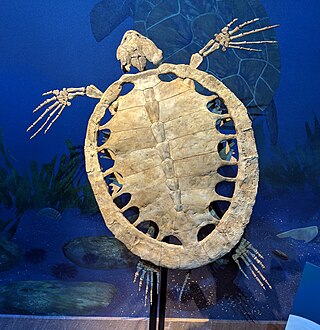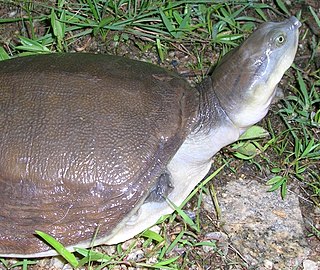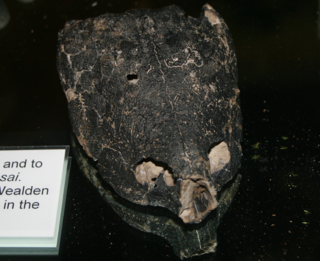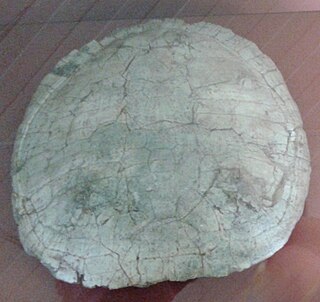
Allopleuron is a genus of extinct sea turtle, which measured 2-to-2.5-metre long in life. The type species is Allopleuron hofmanni. It is a basal member of the clade Pancheloniidae, closely related to Protosphargis. Similar to Protosphargis, it was characterized by shell reduction.

Cycloderma is a genus of softshell turtles in the subfamily Cyclanorbinae of the family Trionychidae. The genus is endemic to Africa.

Euclastes is an extinct genus of sea turtles that survived the Cretaceous–Paleogene mass extinction. The genus was first named by Edward Drinker Cope in 1867, and contains three species. E. hutchisoni, was named in 2003 but has since been reassigned to the genus Pacifichelys, while E. coahuilaensis named in 2009 was reassigned as Mexichelys coahuilaensis in 2010.

The Camarillas Formation is a geological formation in the Teruel Province of Aragón, Spain whose strata date back to the Early Cretaceous. The sandstones, mudstones and conglomerates of the formation, that due to syn-sedimentary faulting varies greatly in thickness from 300 to 800 metres, were deposited in fluvial, deltaic and lacustrine environments.

Pacifichelys is an extinct genus of sea turtle from the Middle Miocene of Peru and California. It was first named by James F. Parham and Nicholas D. Pyenson in 2010, and the type species is Pacifichelys urbinai from Peru. A second species, P. hutchisoni, was reassigned from the genus Euclastes. It is known from the Miocene of California. Like the living Ridley and loggerhead sea turtles, Pacifichelys was durophagous, consuming hard-shelled organisms with crushing jaws.

Cyclanorbinae, also known commonly as the flapshell turtles, is a subfamily of softshell turtles in the family Trionychidae. The subfamily is native to Africa and Asia.

The Trionychinae are a subfamily of turtles in the family Trionychidae.

Baenidae is an extinct family of paracryptodiran turtles known from the Early Cretaceous to Eocene of North America. While during the Early Cretaceous they are found across North America, during the Late Cretaceous they are only found in Laramidia, having disappeared from Appalachia. The majority of lineages survived the K-Pg Extinction, but the family was extinct by the latest Eocene. The name of the type genus, Baena, appears to be of Native American origin. They are primarily found in freshwater deposits, and are considered to be aquatic, with a largely generalist habit.

Polysternon is a genus of turtles in the extinct family Bothremydidae. It was described by Portis in 1882, and contains the species P. provinciale, which existed during the Cretaceous of what is now France; P. atlanticum, which existed during the Cretaceous at Laño in what is now Spain, and a new species, P. isonae, from the Late Maastrichtian of Spain.
Yaminuechelys is an extinct genus of chelid turtle from Argentina and the Dorotea Formation of Chile. The genus first appeared during the Late Cretaceous and became extinct during the Late Paleocene.

Sinemydidae is an extinct family of turtles from Cretaceous to Paleocene deposits in Asia and North America. Their exact position is engimatic, they have alternatively been considered stem-group cryptodires, but also "crownward stem-turtles" alongside Macrobaenidae, Paracryptodira, Xinjiangchelyidae, Thalassochelydia and Sandownidae outside of crown Testudines.

The Helochelydridae are an extinct family of stem-turtles known from fossils found in North America and Europe spanning the Early to Late Cretaceous.

Alienochelys is an extinct genus of sea turtle known from Maastrichian-aged Cretaceous phosphates in Morocco. Its name comes from, unlike other sea turtles, Alienochelys' the jaws being adapted for a powerful crushing pattern, as well as its unusual cranial characteristics. It is a relative of the modern leatherback turtle, as well as the extinct Archelon.

Bauruemys is an extinct genus of turtles in the family Podocnemididae.

Osteopygis is a genus of extinct turtle. Osteopygis, as traditionally seen, is a chimera: the postcrania belong to a non-marine stem-cryptodire, whilst the crania belong to sea turtles. In 2005, the referred material was split between two taxa: the postcrania remained in Osteopygis, while the crania were reassigned to Euclastes wielandi.

Helochelydra is an extinct genus of extinct stem turtle known from the Early Cretaceous (Barremian) of the Isle of Wight, southern England.
Solemys is an extinct genus of stem turtle known from the Late Cretaceous of southern France and eastern Spain.
Arenila is an extinct genus of bothremydid pleurodiran turtle that was discovered in the Western Desert of Egypt. The genus consists solely of type species A. krebsi.

Thanatosdrakon is a genus of quetzalcoatline azhdarchid pterosaur from the Late Cretaceous Plottier Formation of the Neuquén Basin in western Argentina. The genus name is derived from the Greek words thanatos (=death) and drakon (=dragon), while the specific name is a Quechuan word meaning "flying serpent" and refers to the Incan deity Amaru. The type and only species is Thanatosdrakon amaru, known from two specimens consisting of several well-preserved axial and appendicular bones including material previously undescribed in giant azhdarchids. Thanatosdrakon is one of the oldest known members of the Quetzalcoatlinae. T. amaru lived from about 90 to 86 million years ago.
















